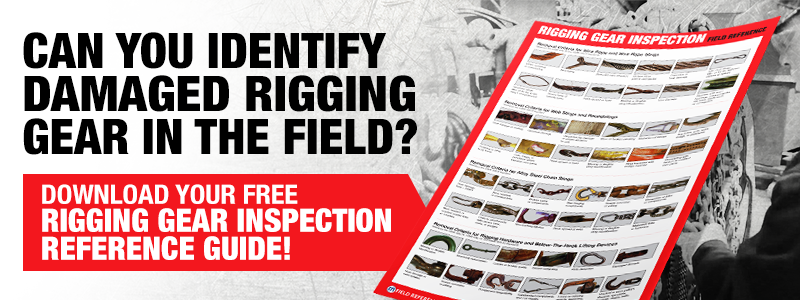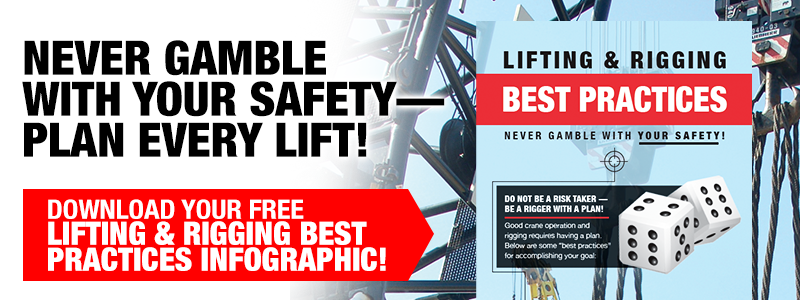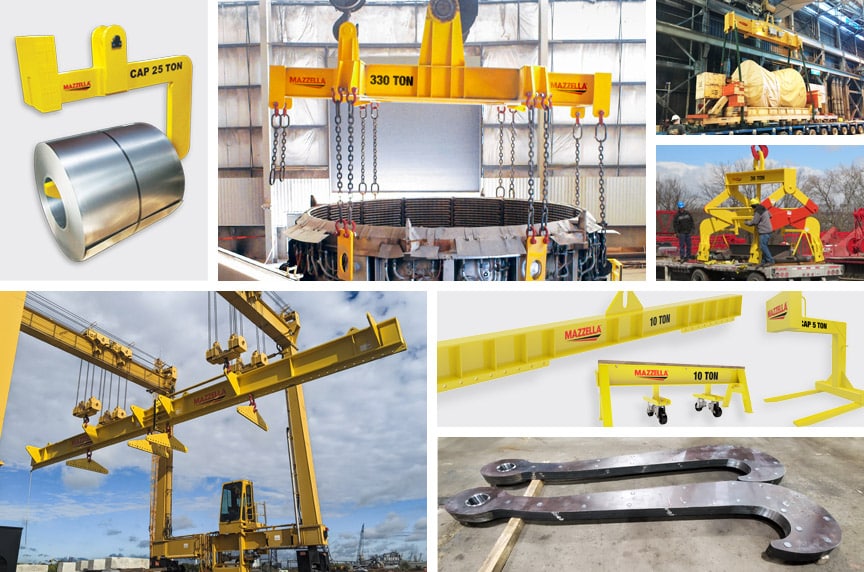What Are ASME’s Inspection Standards for Clamps Used in Overhead Lifts?
What are the inspection standards for clamp lifting devices? The American Society of Mechanical Engineers (ASME) sets the standard for all inspections, including types and frequencies.
Below-the-hook lifting devices come in many shapes and sizes, everything from a magnet lifter to clamps.
There are six types of below-the-hook lifting devices:
- Structural and Mechanical Lifting Devices
- Vacuum Lifting Devices
- Close Proximity Lifting Magnets
- Remotely Operated Lifting Magnets
- Scrap and Material-Handling Grapples
- Clamps
Each device is used for different purposes, and as such, has its own inspection, testing and maintenance requirements. In this piece, we will look at clamps and provide the following information as listed in the ASME B30.20 Below-the-Hook Lifting Devices standard:
- Inspection classification for clamps
- Removal from service criteria
- Testing of repaired clamps
- Maintenance for clamps
What Types of Clamps Are Referenced in ASME B30.20?
There are six types of clamps the ASME B30 Committee has outlined regarding installation, inspection and repair standards for in ASME B30.20:
- Supporting clamps
- Friction-type pressure-gripping clamps
- Indentation-type pressure-gripping clamps
- Anchoring clamps
- Positioning clamps
- Hybrid clamps
A supporting clamp is defined by ASME as “a clamp used to support the weight of a load being lifted.”
A friction-type pressure-gripping clamp is defined as “a clamp that grips the load without significant or harmful permanent deformation of the load surface.”
An indentation-type pressure-gripping clamp is defined as “a clamp that carries the load by applying force to indent the sides of the load.”
Anchoring clamps are defined as “clamps used for suspending or attaching detachable rigging hardware.”
Positioning clamps are defined as “clamps used to hold or locate parts during assembly operations.”
Hybrid clamps, which include barrel lip clamps and bar tongs, “use a combination of categories of clamps” to execute their lifts.
What Is the Inspection Classification of Your Clamps?

There are six types of below-the-hook lifting devices for a reason. Because they are designed for very specific tasks, each has its own inspection and testing requirements. Also, there will be times when repairs need to be done, and the process for inspecting and returning repaired devices to service is outlined in ASME B30.20.
In Chapter 20-6 of the ASME B30.20 Below-the-Hook Lifting Devices standard, the B30 Committee outlines the following for clamps:
- Inspection
- Testing
- Maintenance
General Inspection Requirements
All inspections of clamps shall be performed by a designated person. Any deficiencies identified shall be examined and a determination made by a qualified person as to whether they constitute a hazard, and, if so, what additional steps need to be taken to address the hazard.
Inspection of slings (ASME B30.9), hooks (ASME B30.10), rigging hardware (ASME B30.26), or other special devices shall comply with the inspection requirements in the applicable volume.
Initial Inspection
New and reinstalled clamps shall be inspected prior to initial use to verify compliance with applicable provisions of this Volume.
Altered or repaired clamps shall be inspected. The inspection may be limited to those components affected by the alteration or repair, as determined by a qualified person.

What Inspections Are Performed on Clamps?

Inspection procedure for clamps in regular service is divided into three general classifications based upon the intervals at which inspection should be performed. The intervals, in turn, are dependent upon the critical components of the clamps and the degree of their exposure to wear or deterioration. The three general classifications are herein designated as every lift, frequent, and periodic, with respective intervals between inspections as defined below.
Every Lift Inspection. Visual examination before and during each use of the clamp.
Frequent Inspection. Visual examinations with records not required.
- Normal service — monthly
- Heavy service — weekly to monthly
- Severe service — daily to weekly
- Special or infrequent service — as recommended by a qualified person
Periodic Inspection. Documented visual inspection of apparent external conditions to provide the basis for a continuing evaluation.
- Normal service — yearly
- Heavy service — semiannually
- Severe service — quarterly
- Special or infrequent service — as recommended by a qualified person before the first such lift and as directed by the qualified person for any subsequent lifts
Every Lift Inspection
Clamps shall be inspected by the operator before and / or during every lift for any deficiencies as specifically indicated, including:
- Clamp load contact surface condition
- Engagement
- Obvious clamp damage
Frequent Inspection
Clamps shall be inspected at intervals as defined in para. 20-6.3.1(b)(2). Conditions such as those listed in para. 20 6.3.7, or any other condition that may constitute a hazard, shall cause the clamp to be removed from service.
A qualified person shall determine whether any deficiency constitutes a hazard, requires repair, requires disassembly for further inspection, or will require more frequent inspection. Clamps shall not be returned to service until approved by a qualified person.
***The paragraphs referenced in this section of the standard covers “special or infrequent service” and states inspections should be conducted by a qualified person.
Periodic Inspection
Complete inspection of the clamp shall be performed at intervals as defined in para. 20-6.3.1(b)(3). Conditions such as those listed in para. 20-6.3.7, or any other condition that may result in a hazard, shall cause the clamp to be removed from service.
A qualified person shall determine whether any deficiency constitutes a hazard, requires repair, requires disassembly for further inspection, or will require more frequent inspection. Clamps shall not be returned to service until approved by a qualified person. The inspection shall be based on the manufacturer’s instructions, para. 20-6.3.7, or the recommendations of a qualified person.
***The paragraphs referenced in this section of the standard identify removal from service criteria, which is listed in a following section of this article.
Clamps Not in Regular Use
If your clamps are not used on a consistent basis, how often do they need to be inspected?
A clamp that has been idle for a period of one month to one year shall be inspected in accordance with para. 20-6.3.3 before being placed in service. A clamp that has been idle for a period of one year or more shall be inspected in accordance with para. 20-6.3.4 before being returned to service.
***The paragraphs referenced in this section of the standard discuss how a qualified person needs to conduct inspections and identify hazards.
What Inspection Records Need to be Kept?

Once an inspection is complete, how long do the records need to be kept on file by the end-user?
According to the standard, “Dated inspection reports shall be made on critical items such as those listed in para. 20-6.3.7. Records should be available for each periodic inspection and when the clamp is either altered or repaired.”
***The paragraph referenced in this section of the standard discusses how a qualified person needs to conduct inspections and identify hazards.
What Is the Removal From Service Criteria for Clamps?
A clamp shall be removed from service if conditions (if applicable) such as the following are present (limits established by the manufacturer or qualified person) and shall only be returned to service when approved by a qualified person:
- Deformation, cracks, or wear
- Loose or missing guards, fasteners, covers, stops, or nameplates
- Excessive pitting or corrosion
- Excessive nicks or gouges
- Indications of heat damage
- Unauthorized welds or modifications
- Unauthorized replacement components
- Improper assembly or function
- Impaired, seized, or bound moving parts
- Gripping teeth
- Severely worn
- Broken, chipped, or damaged
- Clogged with foreign material
- Gripping surfaces
- Contamination
- Excessive surface wear
- Lack of integrity of the gripping material
- Lack of bond between gripping material and metal backing
- Damaged or distorted pins
- Bail
- Severely worn
- Bent, twisted, distorted, stretched, cracked, or broken
- Body
- Cracked welds
- Bent, twisted, distorted, stretched, elongated pin holes, or cracks
- Damaged, distorted, or worn threads, including foreign material on the threads
- Deformed, broken, or missing spring(s)
- Broken, worn, or loose cam
- Missing or illegible operating control markings or product safety labels
- Other conditions, including visible damage, that cause doubt as to continued safe use
What Are the Repair Requirements for Clamps?
Deficiencies disclosed by the inspection requirements of Section 20-6.3 shall be corrected according to the procedures outlined in para. 20-6.3.10 before operation of the clamp is resumed, unless a qualified person determines the deficiency does not constitute a hazard. Repairs of slings (ASME B30.9), hooks (ASME B30.10), rigging hardware (ASME B30.26), or other devices shall comply with repair requirements in the applicable volumes or standards.
***The paragraph referenced in this section of the standard outlines what maintenance procedures need to be performed.
What Tests Do Clamps Need Before Being Used in a Lift?

Whether your clamps are new or have been repaired, there are two types of tests that have to be performed on the device to ensure it is in compliance with the standard and ready to be put into service.
Clamps must undergo the following types of tests:
- Operational tests
- Load tests
Operational Tests
New clamps shall be tested by a qualified person, or a designated person under the direction of the manufacturer or a qualified person, prior to initial use to verify compliance with applicable provisions of this Volume, including, but not limited to, the following:
- Moving Parts. Clamps with moving parts shall be tested to determine that the clamp operates in accordance with manufacturer’s instructions.
- Locking Mechanisms. Clamps with manually operated or automatic locking mechanisms shall be tested to determine that the locking mechanism operates in accordance with manufacturer’s instructions.
Altered or repaired clamps shall be tested by a qualified person, or a designated person under the direction of the manufacturer or a qualified person. This test may be limited to the components affected by the alteration or repair, as determined by a qualified person with guidance from the manufacturer.
All indicator lights, gauges, horns, bells, alarms, pointers, and other warning devices shall be tested.
Dated reports of all operational tests shall be filed.
Load Tests
Prior to initial use, all new, altered, or repaired clamps should be tested and inspected. If performed, tests shall be done by a qualified person, or a designated person under the direction of the manufacturer or a qualified person and a written report be furnished, confirming the load rating of the clamp. Test loads shall be 125% +5%/−0% of the rated load unless otherwise recommended by the manufacturer or a qualified person. Test reports should be available.
The load test, if made, shall consist of the following operations as a minimum:
- Hoist the test load a sufficient distance to ensure the load is supported by the clamp, or apply the required load if the test is made using a testing machine.
- After the test load is released, visually inspect the clamp for deformation, cracks, or other defects.
Tests of altered or repaired clamps may be limited to the components affected by the alteration or repair, as determined by a qualified person with guidance from the manufacturer and shall be tested to at least the rated load.
What Maintenance Programs Are Required for Clamps?

No matter how much care one takes with their equipment, eventually parts do wear out and need to be repaired or replaced. A good way to avoid undo wear and tear on your clamps and their components is by following regular maintenance steps that can extend service life.
Maintenance Program
According to ASME B30.20, a maintenance program shall be established and be based on recommendations made by the clamp manufacturer. If a qualified person determines it is appropriate, the program should also include that individual’s additional recommendations based on a review of the clamp application and operation.
Maintenance Procedure
Before adjustments and repairs are started on a clamp, the following precautions shall be taken:
- All sources of power shall be disconnected, locked out, and tagged “Out of Service.”
- A clamp removed from service for repair shall be tagged “Out of Service.”
Only designated persons shall perform adjustments, repairs, and tests.
Replacement parts shall be at least equal to the original manufacturer’s specifications.
After adjustments and repairs have been made, the clamp shall not be returned to service until it has been inspected according to para. 20-6.3.4.
Dated records of repairs and replacements should be made.
Any hazardous conditions disclosed by the inspection shall be corrected before normal operation of the clamp is resumed. Adjustments and repairs shall be done under the direction of, or by, a qualified person.
***The paragraph referenced in this section of the standard states that each inspection shall be conducted by a qualified person to determine if the clamp has hazardous components.
How Can Mazzella Help You with Below-the-Hook Lifting Devices?

If clamps are the correct below-the-hook device for your overhead lifts, Mazzella distributes several types of clamps based on your needs.
However, if clamps are not the correct product for you, we have more than 65 years of experience in designing and developing custom engineered products, below-the-hook lifting devices, and lifting attachments for use with all types of cranes. On-staff engineers and our commitment to the ISO 9001: 2015 standard guide us to continued success in manufacturing quality products and processes.
We can design and fabricate all types of below-the-hook lifting solutions for any application—all of our work is done in compliance with the ASME B30.20 and ASME BTH-1 standards. Our products range from a common lift beam, to an engineered special 150 lb. engine line lifter, to a 330-ton electric furnace lifter.
Along with our line of engineered below-the-hook lifting products, we also design and fabricate an assortment of specialty engineered solutions for all types of applications. These products are designed to meet your specifications, and we make sure our products are in full compliance with industry standards.
Along with design and fabrication, we provide repairs and / or recertifications of below-the-hook lifting devices.
Call us at 800.362.4601 or click here to specify your next below-the-hook project!



Below-the-Hook Lifting Devices
We have more than 65 years of experience in designing and developing custom engineered products, below-the-hook lifting devices, and lifting attachments for use with all types of cranes.
On-staff engineering and our commitment to ISO 9001: 2015 guides us to continued success in quality products and processes.
Copyright 2023. Mazzella Companies.
